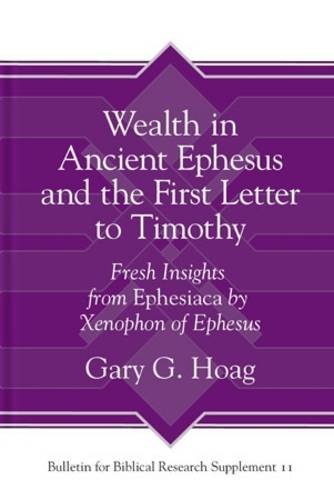Gary Hoag continues——
Texts like 1 Tim 2:9-15 reveal that social and cultural expectations linked to the decorum and deeds of women in God’s house must change dramatically (see chapter three of my BBRS volume). Ephesiaca was instrumental in helping me suggest that the prohibited hairstyle may point to the coiffure that all young ladies were expected to wear to exhibit their piety to the goddess Artemis. This hairstyle was coupled with sumptuous adornment in Ephesiaca revealing that the counter-cultural instruction to women appears to target cultural fixtures in this context. Ephesiaca presents young women going to the temple precincts daily to recite prayers learning in anything but silence and they also participated in promoting the Artemis-Isis-Diana myth. Consequently, the function of this text demythologizes life for Ephesian women.
They were taught from their youth that Artemis was the author of all life and that sin came into the world through man. Worst of all, the social and religious pressure on women was to serve the goddess of childbearing (to get this designation in the ancient Greek mind, Artemis had helped her mother Leto deliver her twin brother Apollo) or else…death (cf. Achilles Tatius, Leucippe and Clitophon 8.6.11–14, Athenaus, The Deipnosophists 15.694D). For women who continue in the faith by choosing counter-cultural service to God will be saved through childbearing, or in plain terms, they need not fear Artemis who was a goddess of vengeance.
Moving into chapter 1 Tim 3, ascension and anticipation of positions of cultic service in Ephesian evidence and Ephesiaca can be linked to wealth and family prominence. While the construct of the qualifications list can be located in ancient evidence as noted by Dibelius and Conzelmann, et al, I demonstrate how those sources reveal that noble birth rather than character was the prevailing cultural pathway to priestly service. In this light, the call for character as a qualification for leadership in God’s house appears as counter-cultural.
Later in that chapter (3:16) we see yet another counter-cultural statement that reads opposite the chant recorded in Acts 19:28, “Great is Artemis of the Ephesians,” and it boldly proclaims: “Beyond all question, the mystery from which true godliness (eusebeias) springs is great: He appeared in the flesh, was vindicated by the Spirit, was seen by angels, was preached among the nations, was believed on in the world, was taken up in glory.” All one has to do is read a few dozen inscriptions in Die Inschriften von Ephesos to see that the wealthy prominent citizens were lauded for their eusebeia to the goddess, Artemis, and to honor any other deity supremely was unthinkable in this setting. The riot of Ephesus is additional evidence for this.
From there, 1 Tim 4 brings the “deceitful spirits” and “doctrines of demons” into view. It was common for Ephesians in crisis to call the cultic leaders for aid. Ironically, Xenophon of Ephesus presents them as pious pretenders whose rituals to placate the demons are fake. More counter-cultural instructions against views that can be linked to the Artemis-Isis-Diana cult come into view in this chapter, such as the prohibition to marry. The author of 1 Timothy states plainly in response the proper course for God’s people. Again in this chapter the living God is the “Savior” of all people. Before doing my research when I heard “Savior” I thought “the God who accomplished my go-to-heaven salvation.” Then when I found it only appears, I think, six times in all the NT and three times in 1 Tim, it seems to have a very intentional function: redefining who the Savior of all in the minds of ancient Mediterranean people.
By 1 Tim 5, we see the counter-cultural treatment of widows. When I researched the Ephebes instruction and learned that prominent citizens would have been taught not to render honor and service to those who could not reciprocate, the instructions to care for widows appears counter-cultural. In 5:9-10 we see those that widows who are to receive aid have a reputation that reflects a lifestyle contrary to the way of living celebrated in ancient sources. Spiritually forming kids, washing feet of the Lord’s people, among other good deeds are services never celebrated by ancient sources in this cultural setting. They reflect Christ-like living and service.
As you can imagine, 1 Tim 6 is a fitting climax to this set of counter-cultural instructions known as the first letter to Timothy. As my research suggests, the false teachers, come into view as the prominent cultic leaders who honor Artemis supremely and the Roman emperor. Around 44 CE, the edict of Paullus Fabius Persicus points out the inappropriate conduct of priestesses and priests of Artemis. They had used the house of the goddess as a front for activities for personal gain (cf. 6:5). It is leading to their destruction and Timothy and others must flee from this thinking. It pervaded the social and cultural context, especially among the rich who were ensconced in power. For Ephesians, you honored the goddess and the emperor and a pantheon of Gods, or else suffer the consequences. In this setting to call God, “the blessed and only Ruler, the King of kings and Lord of lords” (6:15) would be again, squarely attacking the purity rules of this setting.
There are many more points I could make if I went verse by verse, but these come to mind. If people lived in the manner presented by the author of 1 Tim, idol sales would suffer, costly magic books would be deemed worthless, and a riot might ensue…and according to Luke’s Acts, that’s exactly what happened. Elsewhere we learn that Timothy followed these counter-cultural orders and was martyred for speaking out against the practice of pagan feasts (c. 97 CE).













